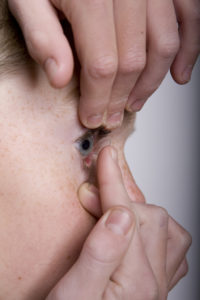October 1, 2020
By Michael Lipson, OD, FAAO, FSLS
 Years ago, the pharmaceutical agent bimatoprost was developed to reduce intraocular pressure and control glaucoma. Patients used it and were monitored for glaucoma control. It worked well for that purpose while doctors observed and patients reported darker, longer and thicker eyelashes. Currently, the same bimataprost medication is prescribed under a different brand name to promote the growth of eyelashes.
Years ago, the pharmaceutical agent bimatoprost was developed to reduce intraocular pressure and control glaucoma. Patients used it and were monitored for glaucoma control. It worked well for that purpose while doctors observed and patients reported darker, longer and thicker eyelashes. Currently, the same bimataprost medication is prescribed under a different brand name to promote the growth of eyelashes.
In a similar vein, OrthoK was prescribed initially and designed to reduce refractive error and provide excellent unaided visual acuity. Over time, an increasing body of evidence showed that children wearing OrthoK lenses had a much slower increase in their myopic refractive error and lesser increases in axial length than children wearing glasses or single vision soft lenses.1 Now, the primary reason practitioners prescribe OrthoK is to slow the rate of myopic progression.2
As a prescriber of OrthoK for both adults and children, it is critical to understand a patient’s motivation to choose OrthoK and assure it meets those expectations. Reasons to select OrthoK include:
- an alternative to vision correction with glasses or daytime contact lenses
- to reduce dependency on vision correction during waking hours
- to help allow participation in activities unsuitable for glasses or contact lenses (particularly, water sports)
- for myopia management in children
- to improve vision-related quality of life
When prescribing OrthoK for adults, the top priority is providing the patient with the best vision. The goal here is to correct all the patient’s refractive error (including astigmatism) for all waking hours while minimizing potential side effects, such as glare, in low-lighting situations. Studies comparing patients’ vision with soft lenses vs. OrthoK show similar visual acuity objectively (on the acuity chart). Still, a majority of patients report better vision with OrthoK subjectively (on questionnaires).3,4 Those studies also report that patients with a higher degree of initial myopia (more than -4.00D) report more issues with night glare while driving. This is due to the increase in spherical aberration created when correcting higher degrees of myopia. New OrthoK patients commonly experience some glare, but many report that they become less aware of it over time. Some practitioners have reported success in reducing the awareness of glare by increasing the diameter of the optic zone of the OrthoK lens. Even with the glare factor, when given a chance to experience both modes of correction in a study, about 70% of patients preferred OrthoK over soft lenses and chose to stay with OrthoK after the study.3
Indeed, when prescribing OrthoK for children, we still want to fully correct their refractive error to provide excellent vision for school, sports, music, computer and all the various visual demands placed on children today. But, in addition to providing clear vision, we want to optimize the effect OrthoK has on slowing refractive error increases and growth of axial length. Customizing the lens design for children may help in this regard.5 Several design factors may play a role in limiting myopia progression, but none have been definitively proven. Factors theorized to affect myopia progression with OrthoK include reduction of the optical zone diameter of the lens6,7 (and the resulting smaller treatment zone diameter), asphericity of the base curve, increased aberrations created8 and decentration of the treatment zone9 (with higher decentration associated with greater myopia control). Even though the younger children in OrthoK do not drive, some have reported being aware of glare with smaller treatment zones and higher baseline degree of myopia.
One more consideration to keep in mind for children is that younger children progress faster than older kids.10 As children get older, the rate of myopia progression naturally slows. Even though axial length can show steady increases through the teens and into the early 20s, 7-year-olds progress faster than 12-year-old children. So whichever mode of myopia management you prescribe, the earlier you initiate an intervention, the greater the effect you will be making in the child’s ultimate axial length and refractive error. A recent peer-reviewed publication11 reminds us that relative to the eye health complications associated with myopia (any degree of myopia, not just high myopia), each diopter of increase prevented is important.
This is relevant when discussing the initiation of myopia management interventions. The age of initiation may vary with the individual child. Some myopic children may be too young to start OrthoK or soft multifocal lenses. Low-dose atropine may be the only option for these patients. In general, children can do quite well with OrthoK at a younger age than with soft lenses. With OrthoK, lenses are worn while sleeping only, not at school or during daily activities, and lenses are handled only at home with parental supervision.
When talking with parents about OrthoK for their child, safety is always a prime concern.12 One study showed no difference in safety for adults vs. children under 12 years old.13 In the most extensive study of its type, OrthoK showed a very low incidence of complications, 7.1 per 10,000 patient-years of wear. The incidence of serious complications was insignificantly different between children and adults.14
In summary, techniques for fitting and monitoring OrthoK on children and adults are similar. Even without design customization, OrthoK has historically shown the ability to slow axial length increases in children by 43 percent to 60 percent.15 More long-term study is needed to determine if we can design OrthoK lenses for even better control of axial length increases.
 Michael J. Lipson, OD, FAAO, FSLS, retired in 2019 from his position as an optometrist and associate professor at the University of Michigan. He has published peer-reviewed clinical research studies on OrthoK, vision-related quality of life, myopia management and new lens designs. Dr. Lipson is the author of the book Contemporary Orthokeratology. He is a consultant to the specialty lens industry, emphasizing OrthoK education. He is on the GPLI Advisory Board, served as vice-president of the Scleral Lens Education Society and served on the Scleral Lens Education Society Board for many years.
Michael J. Lipson, OD, FAAO, FSLS, retired in 2019 from his position as an optometrist and associate professor at the University of Michigan. He has published peer-reviewed clinical research studies on OrthoK, vision-related quality of life, myopia management and new lens designs. Dr. Lipson is the author of the book Contemporary Orthokeratology. He is a consultant to the specialty lens industry, emphasizing OrthoK education. He is on the GPLI Advisory Board, served as vice-president of the Scleral Lens Education Society and served on the Scleral Lens Education Society Board for many years.
References
- Si J-K, Tang K, Bi H-S, et al. Orthokeratology for Myopia Control: A Meta-analysis. Optom Vis Sci 2015; 92:252-257.
- Lipson MJ, Brooks MM and Koffler BH. The Role of Orthokeratology in Myopia Control: A Review. Eye & Contact Lens 2018;44: 224–230.
- Lipson MJ, Sugar A, Musch DC. Overnight corneal reshaping versus soft disposable contact lenses: vision-related quality-of-life differences from a randomized clinical trial. Optom Vis Sci 2005; 82:886–891.
- Santodomingo-Rubido J, Villa-Collar C, Gilmartin B et al. Myopia control with orthokeratology contact lenses in Spain: a comparison of vision-related quality-of-life measures between orthokeratology contact lenses and single-vision spectacles. Eye Contact Lens 2013; 39: 153–157
- Kang P, Gifford P and Swarbrick H. Can Manipulation of Orthokeratology Lens Parameters Modify Peripheral Refraction? Optom Vis Sci. 2013; 90:1237-1248.
- Kang, H. Swarbrick, The Influence of Different OK Lens Designs on Peripheral Refraction, Optom Vis Sci.2016;93:1112-1119.
- Carracedo G, Espinosa Vidal, Tm, Martinez Alberquilla I, et al. Effect of optical zone diameter of orthokeratology lenses over the keratometric profile. Poster Presented at Global Specialty Lens Symposium, Las Vegas, NV 2019.
- Lau JK, Vincent SJ, Cheung S-W, et al. Higher-Order Aberrations and Axial Elongation in Myopic Children Treated With Orthokeratology. Invest Ophthalmol Vis Sci. 2020; 61:22-30.
- Chen R, Chen Y, Lipson M, et al. The effect of treatment zone decentration on myopic progression during orthokeratology. Curr Eye Res. 2019. DOI: 1080/02713683.2019.1673438 https://doi.org/10.1080/02713683.2019.1673438
- Mutti DO, Hayes JR, Mitchell JL, et al. Refractive error, axial length, and relative peripheral refractive error before and after the onset of myopia. Invest Ophthal Vis Sci 2007; 48:2510–2519.
- Bullimore MA and Brennan NA. Myopia Control: Why Each Diopter Matters. Optom Vis Sci 2019; 96:463–465.
- Liu YM, and Xie P. The Safety of Orthokeratology—A Systematic Review. Eye & Contact Lens 2016;42: 35–42.
- Lipson MJ. Long-term Clinical Outcomes for Overnight Corneal Reshaping In Children and Adults. Eye & Cont Lens.2008;34:94–99.
- Bullimore, M., Sinnott, L., and Jones-Jordan, L. The risk of microbial keratitis with overnight corneal reshaping lenses. Optom Vis Sci.2013; 90:937-944.
- Walline JJ, Lindsley KB, Vedula SS, et al. Interventions to slow progression of myopia in children. Cochrane Database of Systematic Reviews 2020, Issue 1. Art. No.: CD004916.
DOI: 10.1002/14651858.CD004916.pub4.











